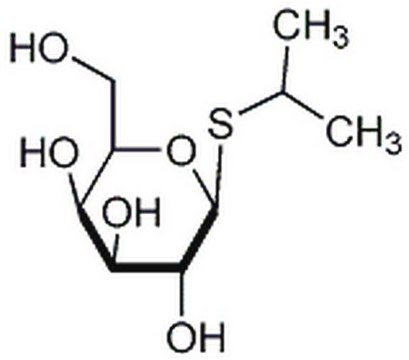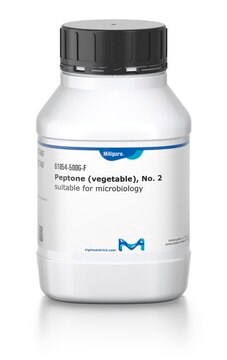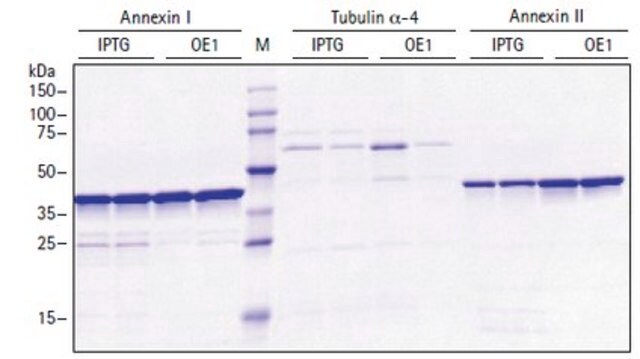PHG0010
Isopropyl β-D-1-thiogalactopyranoside
Synonym(s):
IPTG, Isopropyl β-D-thiogalactoside
Sign Into View Organizational & Contract Pricing
All Photos(2)
About This Item
Empirical Formula (Hill Notation):
C9H18O5S
CAS Number:
Molecular Weight:
238.30
Beilstein:
4631
EC Number:
MDL number:
UNSPSC Code:
12352201
Recommended Products
biological source
synthetic
Quality Level
form
powder
storage temp.
2-8°C
SMILES string
CC(C)S[C@@H]1OC(CO)[C@H](O)C(O)[C@H]1O
InChI
1S/C9H18O5S/c1-4(2)15-9-8(13)7(12)6(11)5(3-10)14-9/h4-13H,3H2,1-2H3/t5-,6+,7+,8-,9+/m1/s1
InChI key
BPHPUYQFMNQIOC-NXRLNHOXSA-N
Looking for similar products? Visit Product Comparison Guide
Related Categories
General description
Our SAFC® portfolio of high-quality raw materials for use in biopharmaceutical processing withstands strict quality control procedures plus the documentation and expertise to help our customers meet requirements as defined by the M-Clarity Program.
M-Clarity Program
Our comprehensive portfolio of upstream process chemicals not only provides biopharmaceutical manufacturers with high-quality raw materials for production of classical and novel therapies, but also helps them get to market faster and simplify regulatory challenges. Trust us to deliver supply chain transparency and reliable sourcing around the globe, streamlining your product qualification with best-in-class regulatory support and service.
M-Clarity Program
Our comprehensive portfolio of upstream process chemicals not only provides biopharmaceutical manufacturers with high-quality raw materials for production of classical and novel therapies, but also helps them get to market faster and simplify regulatory challenges. Trust us to deliver supply chain transparency and reliable sourcing around the globe, streamlining your product qualification with best-in-class regulatory support and service.
Application
IPTG is commonly used in cloning procedures that require induction of β-galactosidase activity. It is used in conjunction with X-Gal or Bluo-Gal in blue-white selection of recombinant bacterial colonies that induce expression of the lac operon in Escherichia coli. IPTG functions by binding to the lacI repressor and altering its conformation, which prevents the repression of the β-galactosidase coding gene lacZ.
Other Notes
Non-metabolizable galactose analog.
Legal Information
SAFC is a registered trademark of Merck KGaA, Darmstadt, Germany
Storage Class Code
11 - Combustible Solids
WGK
WGK 3
Flash Point(F)
Not applicable
Flash Point(C)
Not applicable
Choose from one of the most recent versions:
Already Own This Product?
Find documentation for the products that you have recently purchased in the Document Library.
Customers Also Viewed
Iltaf Ahmed et al.
Human molecular genetics, 24(11), 3172-3180 (2015-02-24)
There are two known mRNA degradation pathways, 3' to 5' and 5' to 3'. We identified likely pathogenic variants in two genes involved in these two pathways in individuals with intellectual disability. In a large family with multiple branches, we
Simon van Vliet et al.
BMC microbiology, 14, 116-116 (2014-06-03)
Bacterial habitats, such as soil and the gut, are structured at the micrometer scale. Important aspects of microbial life in such spatial ecosystems are migration and colonization. Here we explore the colonization of a structured ecosystem by two neutrally labeled
Farshid Hadifar et al.
PloS one, 9(10), e108420-e108420 (2014-10-21)
Killed avian influenza virus (AIV) vaccines have been used to control H5N1 infections in countries where the virus is endemic. Distinguishing vaccinated from naturally infected birds (DIVA) in such situations however, has become a major challenge. Recently, we introduced the
Laam Li et al.
BMC genomics, 16, 637-637 (2015-08-27)
Legionella pneumophila (Lp) is a water-borne opportunistic pathogen. In water, Lp can survive for an extended period of time until it encounters a permissive host. Therefore, identifying genes that are required for survival in water may help develop strategies to
B K Kishore Reddy et al.
Antimicrobial agents and chemotherapy, 58(6), 3312-3326 (2014-04-02)
Pantothenate kinase (PanK) catalyzes the phosphorylation of pantothenate, the first committed and rate-limiting step toward coenzyme A (CoA) biosynthesis. In our earlier reports, we had established that the type I isoform encoded by the coaA gene is an essential pantothenate
Our team of scientists has experience in all areas of research including Life Science, Material Science, Chemical Synthesis, Chromatography, Analytical and many others.
Contact Technical Service









